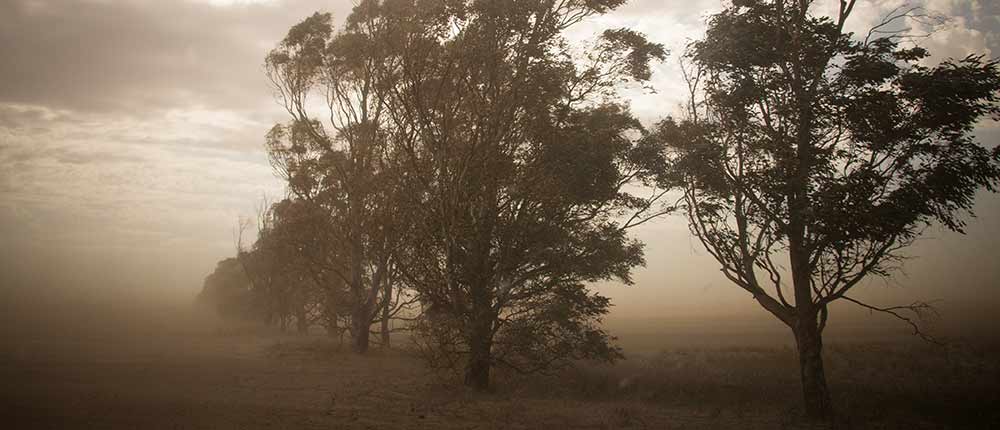Natural events are no more a national concern; rising impact requires international collaborations

A storm is characterized by strong weather phenomena accompanied by strong winds, heavy rains and sometimes snow, sleet, hail or, in contrast, no precipitation at all. Thunderstorms are a type of storm characterized by the presence of lightning and thunder activity - basically, a lightning's acoustic effect on the Earth's atmosphere is known as thunder. It is mostly accompanied by precipitation, though it is not a general rule. In the absence of precipitation when these gusty winds are strong enough to pick up dust and sand particles, it qualifies to be called as a 'Dust storm'.
But besides mere definitions, it is highly imperative to understand the repercussions these events could have in the near future. But why have such events started to garner public attention now? In northern India, these storms have become a 'new normal'. The question which arises here is, were these storms as common in occurrence and intensity about a decade back as they are now? If not, is this increasing frequency and the ferocity something we should be worrying about? Storms in the past have never been serious enough to take away lives, but if one is to pay attention to a state relief commissioner's office spokesperson who told the newspapers that the death toll in early May this year was the highest from such storms in at least the last 20 years, there may be a reason for concern.
So is this something that we should be prepared to face?
What makes such storms unusual and important?
It is not the occurrence and the timing of the storms which is surprising but the intensity and the frequency that seems worrisome. Almost in all the cases, any rainfall which is abrupt and takes place outside the monsoon months is either regarded as 'the result of Western Disturbances' or an outcome of 'Global Warming and Climate Change'.
But can these regional or global phenomena be held primarily responsible at all times?
It turns out that being a large scale phenomenon, they do play an important role in setting up the conditions for the genesis of roaring winds, but there are many other factors which shape the arrival and intensity of these storms. With global temperatures rising, strong pressure gradients are formed which generate stormy winds. Hence, climate change could be the driver of furious storms in near future. But climate has always been changing and western disturbances been visiting India from the Middle East every year, so why such a peculiarity this year?

Many reasons are being suggested behind such unusual events. It has been pointed out in one of the reports in 'Weather Company' that the recent conditions in India could be seen as similar to that in Midwest USA. Conditions characterized by front formation, which generate storms in USA, may be synonymous to a condition in India where the moist inflow from the Bay of Bengal, traveling north-westward up the Ganges Valley, sometimes clashes with dry air from western India beneath a westerly jet stream thereby resulting in the formation of a front. These contrasting air masses lead to the development of storms which might congeal overnight to form thunderstorm clusters called Mesoscale Convective Systems (MCSs).
Since temperatures are very high for this time of the year across and west of North India (April - July), it may facilitate strong and intense downward air movements which move outwards and back up from the MCSs during a thunderstorm giving rise to a phenomenon called downbursts. Because winter and early spring are typically very dry across northern India, any high winds can generate plenty of dust. As an MCS matures, its high winds can push well ahead of any rainfall, manifesting as strong, dry, dusty storms. Since high temperatures and absence of moisture in the Rajasthan region of India prevail for most part of the year, the desiccated conditions along with intense low pressure centres created in these areas could have resulted in gushing dust laden winds which engulfed the 'concrete jungles' in and around Delhi in the form of the early June 2018 dust storms.
The effect of these winds has extended beyond its spatial and temporal limits. As we designate 17th June as the 'World Day to Combat Desertification and Drought', we forget to actually estimate the rate at which it is encroaching into our habitats; the habitats which were untouched by them until recently. It is this dust in the atmosphere which does not allow the heat from the ground to escape and hence, the problem of high temperatures seems to worsen. The northern parts of India continue to 'incinerate' while heatwaves 'char' and dust storms 'choke' people to death. Since temperatures keep escalating, the pressure gradients make the conditions more lucrative for the storms to form; hence, forming a vicious loop!
What are the impacts?
Severe dust storms, thunderstorms, and lightning hit several parts of India in the last few months, resulting in the death of at least 124 people and injuries to 300 others across five states - Rajasthan, Uttar Pradesh, Telangana, Uttarakhand, and Punjab. The losses of life and property throughout the northern parts of the country were high as the storms hit one of the most populous belts where even a single extreme event would mean tremendous losses.
Dust storms which struck the region in the early June spiked the PM2.5 and PM10 concentrations in the atmosphere, adding more to the already high pollution levels. The Central Pollution Control Board data showed that the PM10 level was beyond 'severe', leading to hazy conditions and limiting visibility. These particles have a long-term impact on humans. The World Meteorological Organization states that they are capable of damaging not only external organs (mostly causing skin and eye irritations) but also get trapped in the nose, mouth and upper respiratory tract and can cause respiratory and cardiovascular disorders. Additionally, dust storms have negative impact on agriculture. They reduce crop yields by burying seedlings, damaging plant tissues, reducing photosynthetic activities and by increasing soil erosion. Indirect dust deposit caused by such storms fill up irrigation canals, cover transportation routes and impact river and stream water quality.
What could be the solutions?
Unlike in the US, storms and lightning are never considered a major threat in India except when the affected regions are the coastal areas. The challenges are three-fold - technical measures that are needed for such localized forecasts, the expertise in interpreting and communicating the event, and the mechanism to disseminate forecasts.
India at large lacks a comprehensive and effective storm and lightning-strike warning system, except in certain states like Andhra Pradesh and Telangana. Scientists believe that storms could be forecasted two days in advance, while they are still forming, though their intensity and the exact location could be predicted only closer to the event, leaving very short lead time of say, roughly two hours for mitigating its damages. A meteorology expert and Associate Professor at the Indian Institute of Technology-Bombay told India Climate Dialogue that radar observation could track and predict the direction of thunderstorm and issue local forecasts even within that lead-time and save lives. Almost all states have active warning systems in place with IMD and NDMA forecasting them but they still lack in the robust outreach facilities. Uttar Pradesh, the biggest loss bearer this year due to storms, has a comprehensive storm/hurricane management Plan under UPSDMA in place. Faced by tremendous damage this year, it is highly critical for UPSDMA to gear up and strive for the better and more efficient implementation of the management plan in order to minimize any future losses. Andhra Pradesh and Telangana should therefore act as model states for their work in storm warning systems and other state governments should try to emulate them.

Certain regional and global models are in place to monitor and forecast dust storms. China has been monitoring dust storm events since the 1950's as part of routine weather monitoring (Wang et al., 2008). The regional model CUACE/Dust (Chinese Unified Atmospheric Chemistry Environment for Dust) is capable of producing 24-hour, 48-hour, and 72-hour forecasts from the model. The global forecasting model, BSC-DREAM8b, has the ability to identify and project dust storms, providing forecasts in six hour intervals from real time to 72 hours in the future, for four substantial dust producing regions in the world (North-west Africa, North-eastern Asia, Spain and Middle east). Since these models do not cover the Indian region, it is high time for scientific communities and institutions like National Disaster Management Authority (NDMA) and State Disaster Management Authorities to develop interest in this field and come up with a research or a model which could forecast these 'dusty evils'.
There has not been much attention of the policy makers diverted towards this hazard. SAARC STORM Program, a multidisciplinary nationally coordinated R&D programme carried out for the time frame 2008-2015 has been one of the few notable initiatives undertaken to provide early warning systems for storms in India and a few neighbouring countries. However, this programme is myopic in its coverage and only concentrates upon eastern parts of India that bear the brunt of pre-monsoon thunderstorms called 'Kal-Baisakhi'. A similar programme could either be implemented for the northern and western parts of the country or the existing programmes could be extended to cover the areas which are under the newly developed risks of storms. This programme could also be seen as an opportunity for India to showcase its leadership quality, where NDMA could collaborate with the Ministry of External Affairs and draft a storm mitigation programme for its non-coastal areas, which could then be extended to the disaster prone neighbouring countries.
There are also many programmes which have been undertaken under the pilot project 'The Severe Weather Forecasting Demonstration Project (SWFDP)' under WMO. One such programme is 'Sand and Dust Storm Warning Advisory and Assessment System (SDS-WAS)' established in 2007 in response to the intention of 40 WMO member countries to improve capabilities for more reliable sand and dust storm forecasts. India being a member of WMO is 'insured' under the programme but such global initiatives fail to bear fruits if efforts are not taken for its micro-level implementation. Since dust storms are a trans-boundary issue, such global or regional initiatives would serve best for their mitigation as they work on the principle of combined responsibility, where a hazard becomes a mutual problem to be combated. India needs to address this gap in the integrated pan-India storm forecasting system and actively bring together relevant institutions to work towards its implementation.
A forecast contributing to early warning can provide a 'real warning' only if it is properly communicated and disseminated among the masses. Poor education and awareness on how to safely respond to lightning and storms still remains an obscurity and people are elusive enough to neglect it. This especially takes place in areas which are recently introduced with novel natural hazards that the natives have never faced before. Such unprepared masses are the most vulnerable. Hence, awareness programmes should be undertaken at the grass root level on priority by involving Village Panchayats, concerned organizations and NGOs for complete implementation of mitigation programmes.
Increasing forest covers (on the lines of the announcement made under India State of Forest Report, 2015) to almost 33% of the country's total geographical area; mulching; preventing overgrazing; alternating concrete jungles with green covers, etc. could be some of the other steps which could be undertaken to mollify the negative impacts.
It is crucial for us to understand that this problem would continue to haunt us every pre-monsoonal season if not paid heed to. While nature remains beyond our control, we as responsible homos could do only our bit and help in making such natural events less intense.
